Aging in place means making your home work for you—at every stage of life. It’s about staying in your favorite place, feeling safe and comfortable as you get older.
Remember to repin your favorite images!
The best design strategies make your home more accessible, safer, and yes, still beautiful, so you can keep your independence.
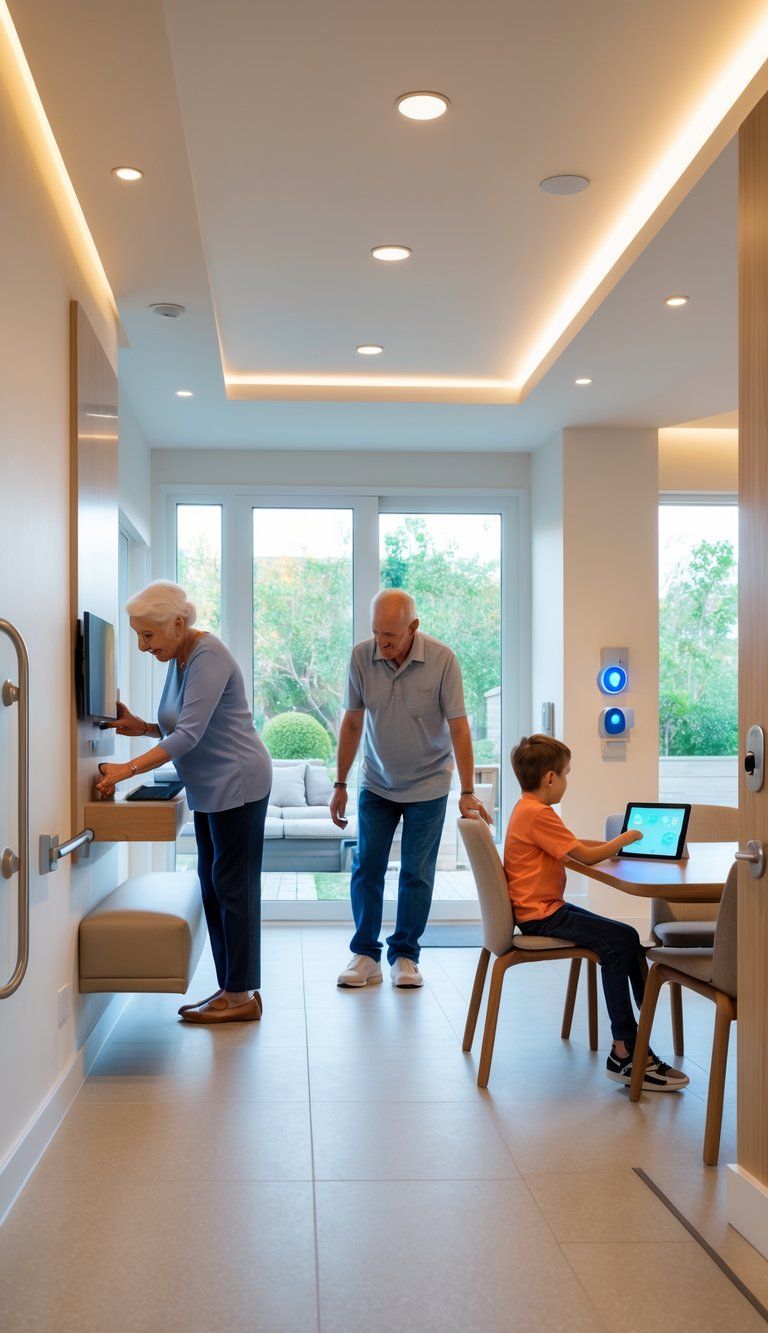
When you plan your home, think about what you’ll need down the road. Even small changes like wider doorways, curbless showers, or better lighting can make a big difference later.
These updates don’t have to look “medical.” Modern aging-in-place design can be both practical and stylish.
Smart home tech, safer bathrooms, and open layouts that make it easy to connect with others all help. If you get rid of tripping hazards and keep storage within reach, you make life easier for everyone.
What’s great about these designs is how they work for every age, not just seniors.
Core Principles of Aging in Place Design
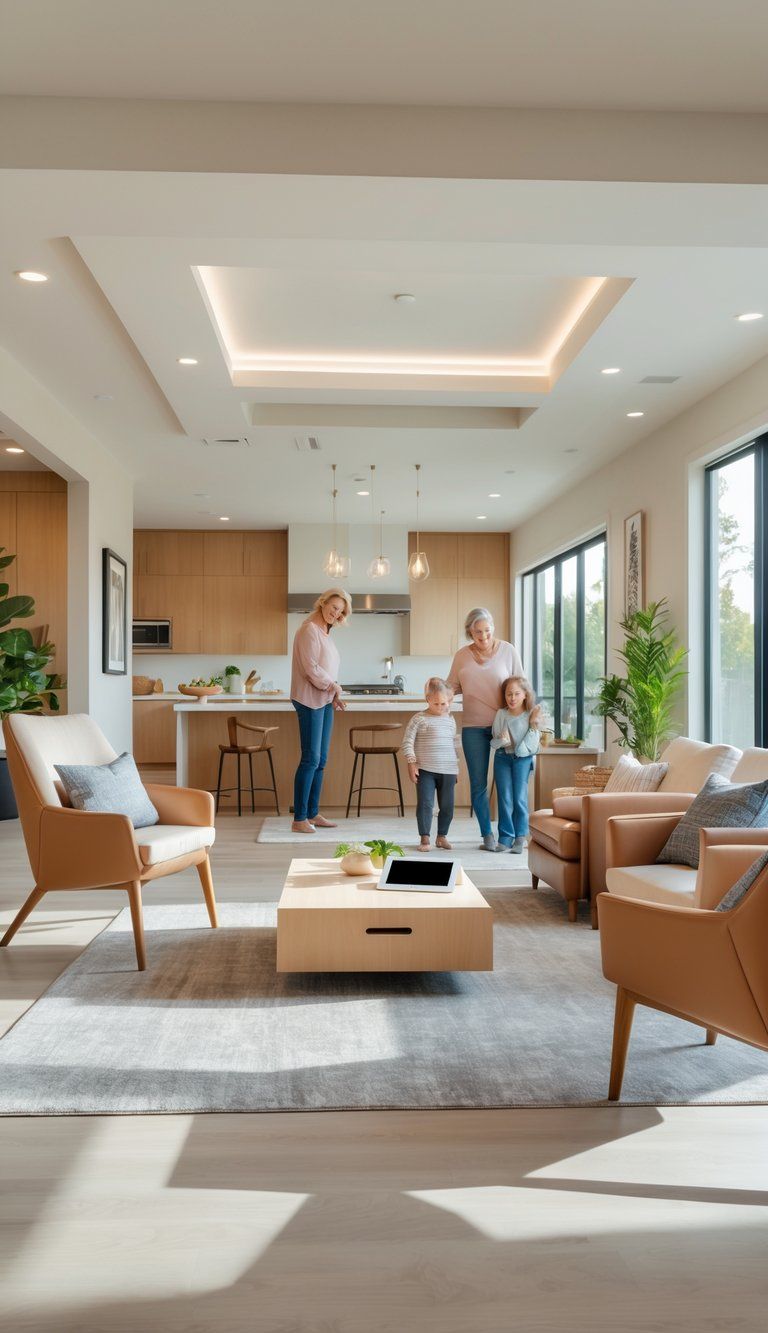
Aging in place design comes down to smart planning and practical tweaks that help you stay independent. The best homes feel welcoming for anyone, at any age.
Understanding Universal Design Principles
Universal design is all about making spaces work for everyone, no matter your age or ability. The idea is to keep things usable for all, without needing big changes later.
The seven core principles are:
- Equitable Use: Works for people with different abilities
- Flexibility: Fits lots of preferences
- Simple and Intuitive: Easy to figure out, no matter your experience
- Perceptible Information: Gets the info across clearly
- Tolerance for Error: Reduces the chance of accidents
- Low Physical Effort: Doesn’t wear you out
- Size and Space for Approach: Enough room, even if you use a wheelchair or walker
These ideas help your home grow with you. If you blend them in from the start, you don’t end up with clunky add-ons later.
Designing for Accessibility
Accessible homes remove barriers that could get in your way. Good design here feels thoughtful, not clinical.
Some key features:
- Zero-step entries at doors and garages
- Wider doorways (at least 36 inches)
- First-floor bedroom, bathroom, and laundry
- Lever-style door handles
- Rocker light switches at reachable heights
Bathrooms need extra attention. Walk-in showers with benches, towel bars that double as grab bars, and higher toilets all help.
In the kitchen, mix up counter heights, add pull-out shelves, and leave space for sitting while you work. These changes make life easier for everyone.
Balancing Comfort and Safety
Your home shouldn’t feel like a hospital. Good design finds a sweet spot between safety and comfort.
Lighting is huge. Use:
- Task lights where you work
- Motion-sensor lights for nighttime
- As much natural light as you can
- Diffusers or better placement to cut glare
Floors matter, too. Try:
- Non-slip surfaces in bathrooms and kitchens
- Smooth transitions between rooms—no big thresholds
- Contrasting colors between floors and walls to help with depth perception
Smart home tech gives you a boost here. Voice controls, remote monitoring, and automated lights all make things easier and offer peace of mind.
Planning and Assessing Your Home Environment

Before you jump into changes, take a good look at your home and what you’ll need—now and in the future. This step helps you create a place that fits your life today and adapts later.
Conducting a Home Assessment
Walk through your home and notice the trouble spots. Loose rugs, dim lights, or tricky stairs? These can become real problems.
Check these areas:
- Entry points: Are doors wide enough for a walker or wheelchair?
- Floors: Are they flat and non-slip?
- Lighting: Are all areas bright, especially stairs and halls?
- Bathroom safety: Would grab bars or a walk-in shower help?
- Kitchen access: Can you reach cabinets and appliances easily?
Think about what you need now and what might come up later. Base your checklist on your health, mobility, and how you like to live.
Professional Consultation and Guidance
Experts can spot things you might miss. You might want to talk to:
- Certified Aging-in-Place Specialists (CAPS): They know what works for older adults and can suggest changes.
- Occupational therapists: They see how you use your home and offer practical fixes.
- Interior designers: They help you stay stylish and accessible.
- Contractors with accessibility experience: They know what’s doable for your house.
These folks can help you plan changes that fit your needs and your budget.
Personalization and Adaptability
Your home should feel like yours, even as your needs shift. Choose flexible features you can adjust as life changes.
Some options:
- Counters with adjustable heights
- Cabinets with removable fronts for wheelchair access
- Smart home tech you can add onto later
- Modular furniture you can rearrange
You really don’t have to give up style for function. Pick changes that look good and make life easier. Universal design works for everyone, so it’s a win-win.
Set priorities. Some updates might be urgent; others can wait and be added over time.
Smart Home Technology and Security
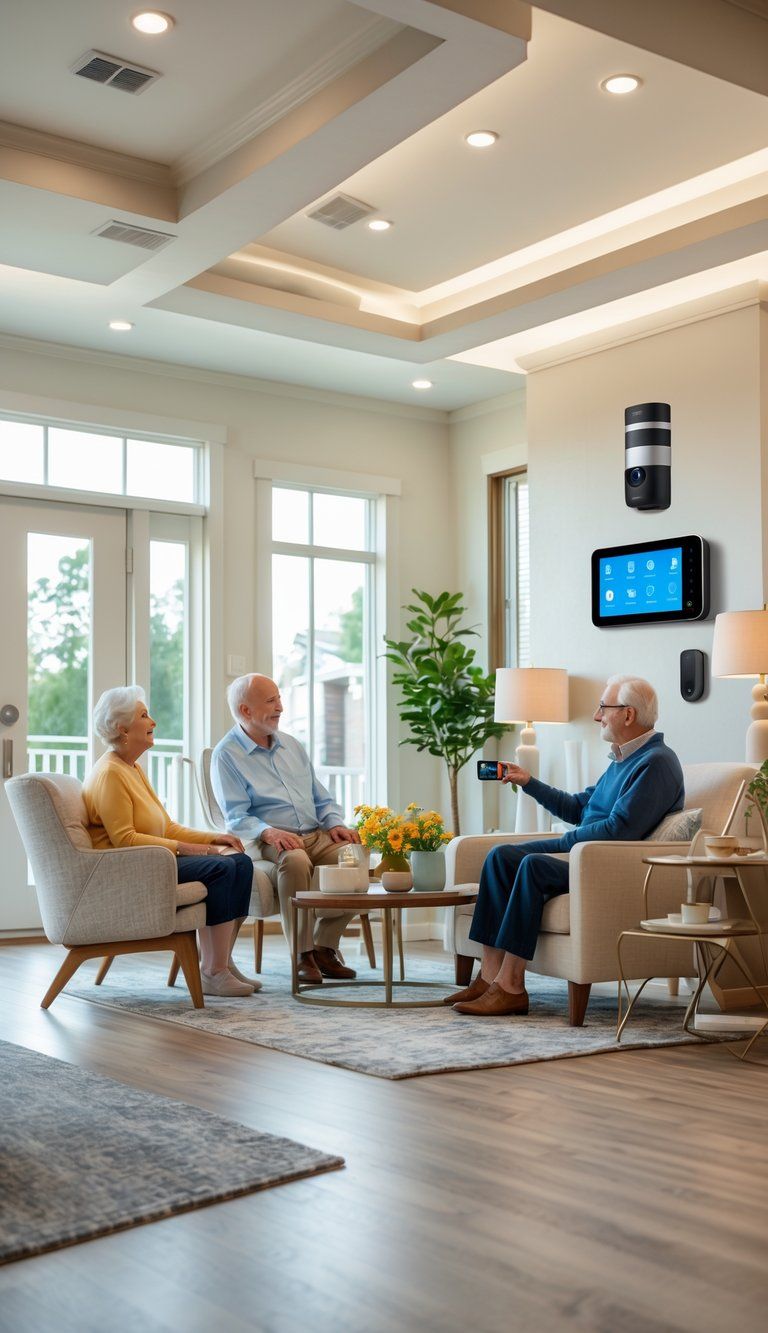
Technology has become a big help for aging in place. Smart devices and security systems add safety and convenience, not just for older adults but for everyone.
Integrating Smart Home Devices
Smart home tech can really change how you live. Voice assistants like Amazon Echo or Google Home let you control lights, temperatures, and appliances without having to walk around.
Smart thermostats learn what you like and adjust themselves, saving energy and keeping you comfy. You can even control them from your phone.
Some appliances send alerts when laundry’s done or if you left the fridge open. Video doorbells let you see who’s at the door without getting up.
Smart pill dispensers remind you to take medicine and track if you missed a dose.
Home Security Systems and Safety Features
Today’s security systems do more than just sound alarms. Look for:
- Big, easy-to-use buttons or touchscreens
- Remote monitoring for family
- Emergency buttons that connect right to help
- Water leak and smoke detectors that ping your phone
Some systems even check if your routine changes—if you haven’t moved around by a certain time, it alerts someone.
Smart locks mean you don’t have to mess with keys. You can give access to caregivers or family at set times.
Motion Sensors and Automation
Motion sensors help keep things safe by turning on lights as soon as you walk in. No more fumbling for switches in the dark.
Some smart floors detect falls and send alerts if someone isn’t moving. They can even notice changes in walking that might mean a health issue.
Automated blinds and curtains open and close on a schedule or with your voice. Motion-activated faucets help you avoid leaving water running.
Lights that come on at night when you move around make it safer to get to the bathroom, especially when you’re groggy.
Accessible Entryways and Open Layouts
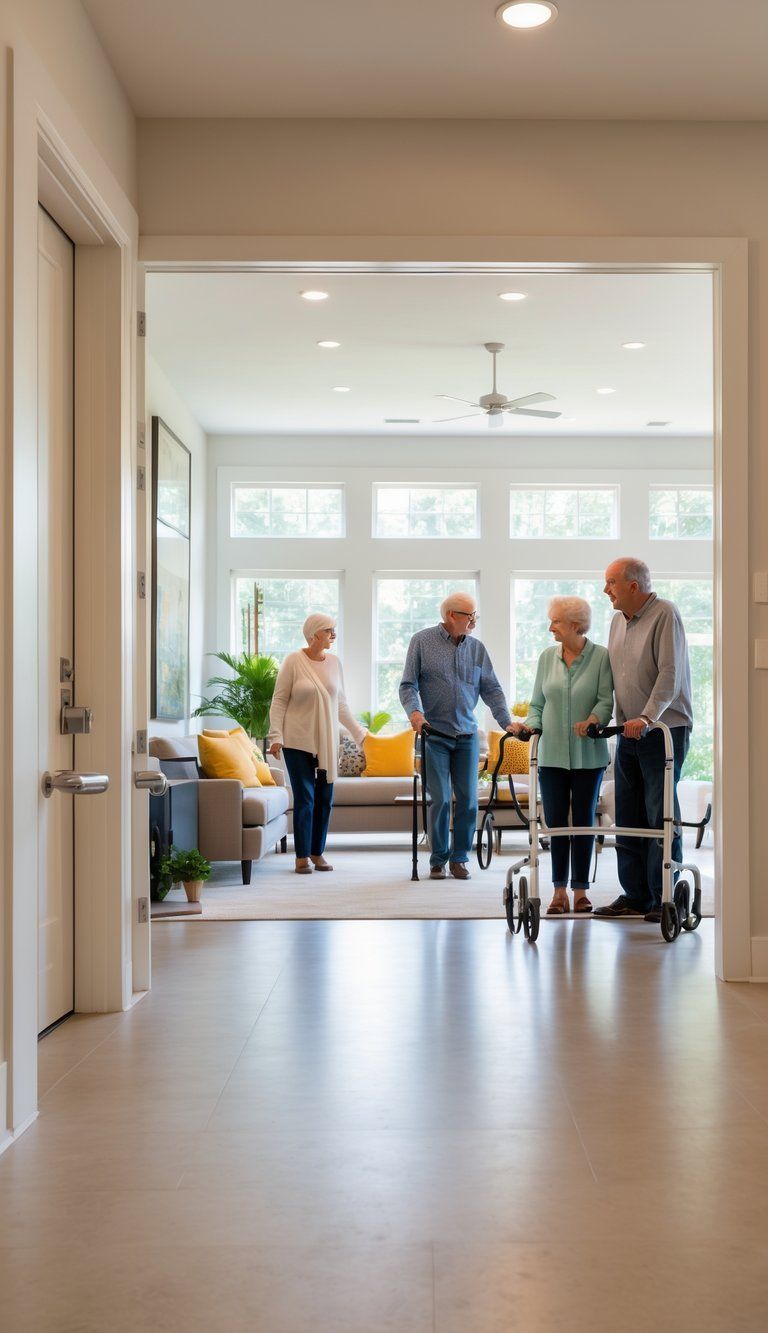
Welcoming entryways and open spaces make a huge difference for aging in place. Smart choices here prevent accidents and help everyone move around more easily.
No-Step Entry and Wide Doorways
No-step entries get rid of one of the biggest hurdles for folks with mobility issues. Try to have at least one zero-threshold entrance—maybe through the garage or front door.
This isn’t just for wheelchair users; it helps parents with strollers and anyone carrying groceries.
Doorways should be at least 36 inches wide. That way, wheelchairs and walkers fit without a squeeze.
You can:
- Add offset hinges to get a bit more space
- Use pocket or barn doors if space is tight
- Remove or bevel thresholds to keep them under half an inch
Don’t forget lighting. Motion-sensor lights at the door mean you never walk into darkness.
Open Floor Plans for Mobility
Open layouts create clear pathways and make moving around easy for everyone. If you remove extra walls between the kitchen, dining, and living areas, you get a space that’s easy to navigate and socialize in.
Open floor plans offer:
- Better visibility, so caregivers can keep an eye out from different rooms
- Plenty of space for wheelchairs or walkers—aim for a 5-foot turning circle in key spots
- Flexible furniture placement for changing needs
Keep floors consistent between rooms and ditch raised thresholds. Skip area rugs—they’re just tripping hazards.
Arrange furniture so you have at least 36 inches of pathway wherever you walk. Don’t push everything against the walls—leave room for access from all sides.
Living Areas and Furniture Choices
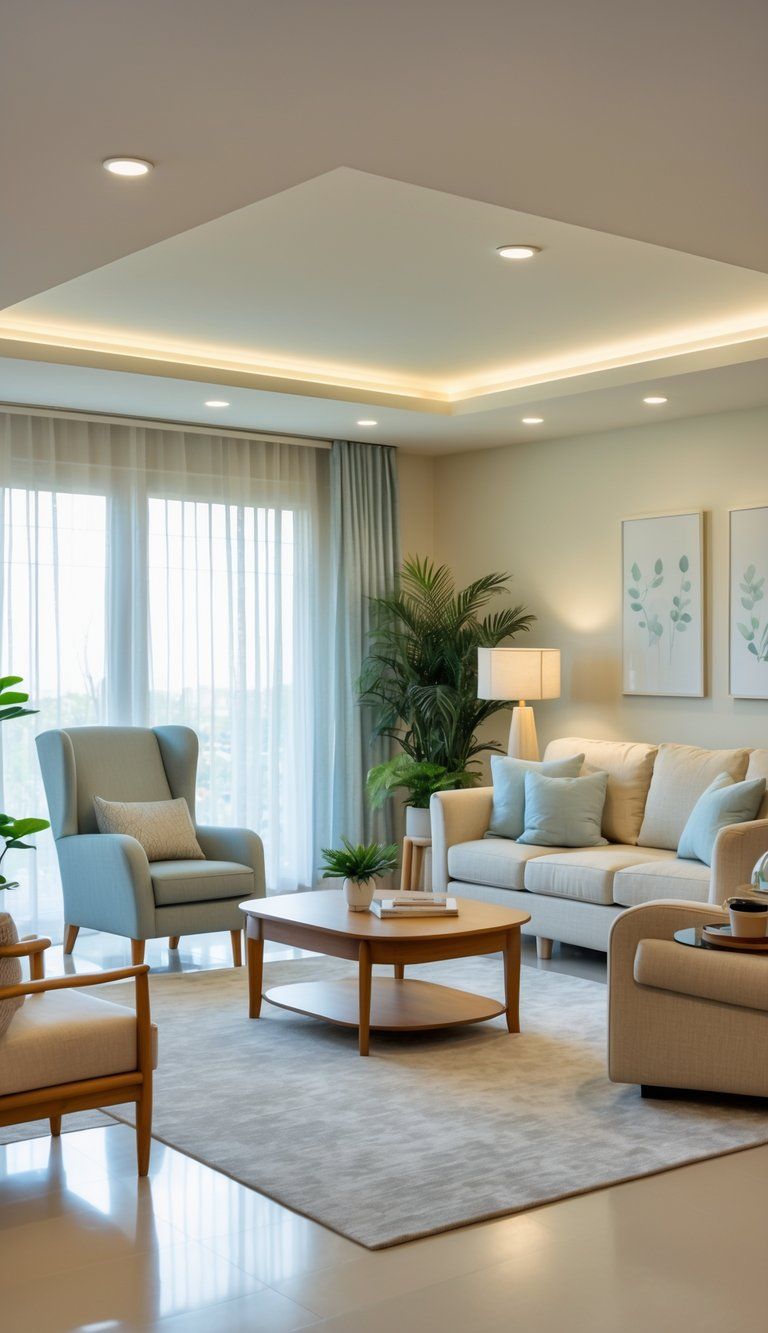
Your main living spaces need to work for you now and later. Smart furniture and thoughtful layouts help your home adapt as you age.
Barrier-Free Living Spaces
Open floor plans cut down on obstacles. Make sure doorways are at least 36 inches wide for walkers or wheelchairs.
Keep thresholds low—or get rid of them. If you can, take out unnecessary walls between living, dining, and kitchen areas.
Good lighting is key. Motion-sensor lights in halls and adjustable lighting you can brighten as needed are both great. Let in as much natural light as possible—it lifts your mood and helps prevent falls.
Pick flooring that’s non-slip, like low-pile carpet, vinyl, or cork. Avoid throw rugs—they’re just asking for trouble.
Accessible Furniture and Mobility Aids
Choose furniture that’s supportive and the right height. Chairs and sofas should be 17-19 inches off the floor, with sturdy arms to help you get up.
Firm cushions are better than ones you sink into. Adjustable beds, power recliners, and tables with changing heights can make life easier as your needs shift.
Arrange furniture to leave 36-inch walkways between pieces. Make sure you can approach seating from different angles.
Install storage at different heights so you don’t have to bend or stretch. Drawers with full-extension slides and pull-down cabinet shelves are handy.
If you need extra support, add grab bars that match your style—some look just like regular towel bars. Modern designs blend right in.
Optimizing Bathroom Design for Aging in Place
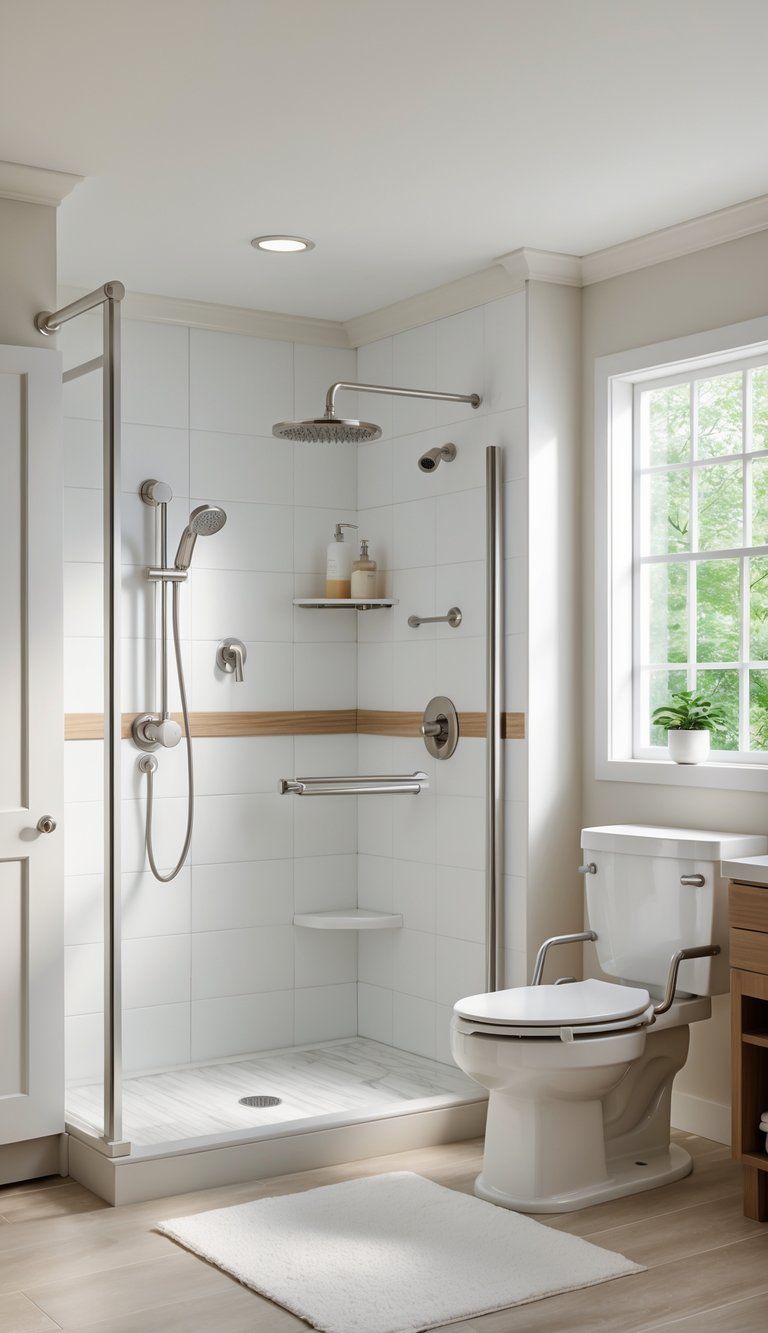
Bathrooms might just be the riskiest spot in the house for accidents. But if you make smart design choices, you can turn these spaces into safe, accessible zones that help you stay independent at any age.
Non-Slip Surfaces and Flooring
Falls in the bathroom can really mess things up, especially as you get older. Non-slip flooring is basically your first line of defense.
Textured tiles grip your feet, even when everything’s wet. Try to find tiles with a coefficient of friction (COF) of 0.42 or higher—those will help you stay steady. Porcelain tiles with a matte finish look good and help prevent slips.
Small mosaic tiles are handy because all those grout lines add extra traction. If you’re into bigger tiles, just make sure they’re textured enough.
Cork and rubber flooring are also great choices. They’re soft underfoot, don’t get slippery, and can cushion a fall if it happens.
Throw down some non-slip mats in front of the sink and shower. Mats with rubber backs don’t bunch up or slide around, which is exactly what you want.
Barrier-Free and Curbless Showers
Curbless showers take away the need to step over any kind of ledge, which is a huge win for aging in place. These walk-in showers create a smooth path from the bathroom floor right into the shower.
They’re super accessible—wheelchair users can roll straight in, and anyone with mobility issues doesn’t have to worry about tripping. Make sure the floor slopes gently toward a linear drain so water goes where it should.
Modern curbless showers can look pretty sleek. Glass panels keep things open and still contain splashes. Add a bench seat inside so you can sit and relax while bathing.
Pop in a handheld showerhead on a slide bar. That way, you can shower sitting down if you ever need to.
Walk-in tubs are another option. They come with features like whirlpool jets, but they take up more space and might need extra plumbing.
Grab Bars and Handrails
Grab bars are a must for bathroom safety. These days, you can get designs that blend right in with your style and still give you the support you need.
Install grab bars next to the toilet—both sides if you can swing it—and inside and at the entrance to the shower. Go for bars with a diameter of 1.25 to 1.5 inches for a comfortable grip. They should hold at least 250 pounds.
Textured grab bars are less slippery when your hands are wet. Diagonal bars help whether you’re standing up or sitting down.
Skip using towel racks or soap dishes for support—they’re not made to hold your weight. Instead, anchor grab bars into wall studs so they’ll actually help if you need them.
You can find grab bars in all sorts of finishes now, like brushed nickel, bronze, or matte black, so matching your fixtures is pretty easy.
Adjustable Fixtures and Raised Toilet Seats
Comfort-height toilets sit 17-19 inches off the floor, which is a couple inches higher than standard ones. That little boost makes sitting and standing way easier.
If swapping out your toilet isn’t in the cards, add a raised toilet seat. These add 2-4 inches and some have handles for extra help. Just make sure they attach firmly and don’t wiggle.
Adjustable-height vanities are a smart move. You can tweak them as your needs change. Wall-mounted sinks give wheelchair users plenty of knee room.
Lever-style faucet handles beat out knobs, especially if you have arthritis. Or just go for touch-activated or motion-sensor faucets—no gripping needed.
Anti-scald devices are a good idea too. They keep water temperature steady, which helps protect sensitive skin.
Kitchen Design and Safety Considerations
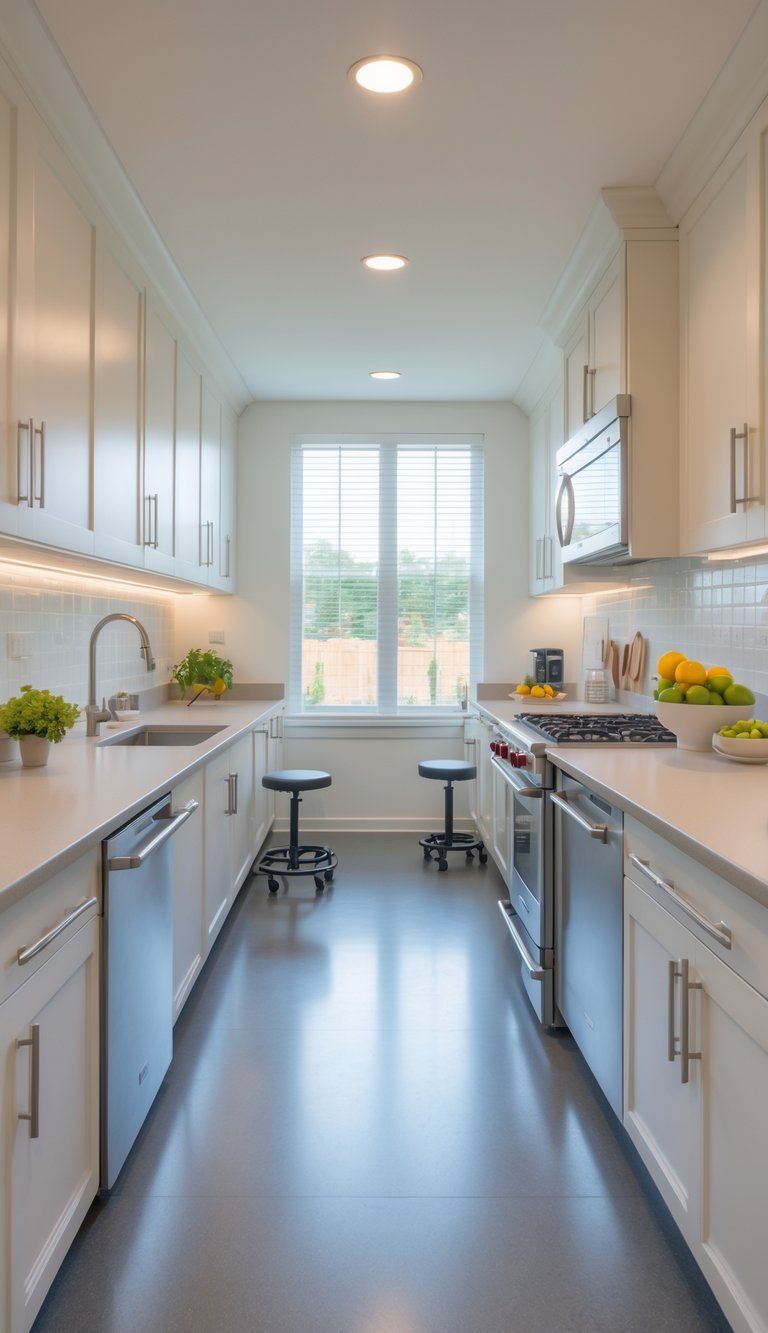
The kitchen is the heart of the home for a lot of people. But as the years go by, it needs thoughtful design to stay safe and accessible. If you combine practical ideas with features that can adapt over time, you’ll be set.
Ergonomic Layouts and Open Spaces
A good kitchen layout matters a lot for aging in place. The classic work triangle—sink, fridge, stove—should be close enough to cut down on steps, but also roomy enough for a walker or wheelchair.
Wide doorways (aim for at least 32 inches) make it easy to get around. If you can, ditch thresholds between rooms for smoother movement.
Open floor plans get rid of obstacles and improve sightlines. A 5-foot turning radius gives wheelchairs plenty of space to maneuver.
Keep your most-used stuff between waist and shoulder height. That way you won’t have to bend or stretch too much, which is easier on your joints and helps prevent falls.
Lighting is huge as your vision changes. Layer it up—add under-cabinet lights, some task lighting, and general lighting to keep shadows at bay.
Pull-Out Shelves and Accessible Storage
Traditional cabinets make you reach and bend in awkward ways. Pull-out shelves fix that by bringing everything out to you.
Full-extension drawers with sturdy handles make it easy to grab pots, pans, and tools. Swap out fixed shelving in lower cabinets for these drawers if you can.
For upper cabinets, try pull-down shelving systems. They’re pricier but really boost accessibility.
Open shelving for everyday stuff cuts down on reaching. Just keep shelves at a comfortable height.
Lazy Susans in corner cabinets make use of tricky spaces. Just spin them to bring things right to the front.
Lever-Style Door Handles and Controls
Lever handles are way easier on your hands than knobs—especially if you have arthritis or weak grip. Swapping them out is a quick win for accessibility.
Pick faucets with lever or touch controls. Single-handle models are simpler to adjust than two-knob styles. Touch or motion-activated options mean you don’t have to grab anything.
Put appliance controls on the front whenever you can. That way, you won’t need to reach over hot surfaces or strain to reach the back.
Big, clear buttons and high-contrast digital displays make appliances easier to use. Look for safety features like auto shut-offs too.
Cabinet pulls should be D-shaped, not round. You can open them with a closed fist if you need to. Keeping them consistent throughout the kitchen just makes life simpler.
Adjustable Countertops and Task Areas
Mixing up counter heights helps different users and tasks. Standard 36-inch counters work for most standing tasks, but lower 30-inch sections are better for sitting.
If you can, put in an adjustable-height countertop. Some motorized models move up or down with the push of a button.
Pull-out work surfaces are handy in small kitchens. They give you extra space when you need it and disappear when you don’t.
The sink deserves special attention. Shallow basins mean less reaching, and open space underneath lets you use it from a chair. Wall-mounted or adjustable sinks work best for flexibility.
Anti-fatigue mats in front of your main work areas can really help if you spend a lot of time in the kitchen. Just make sure the edges are beveled to avoid tripping.
Lighting, Visibility, and Color Contrast
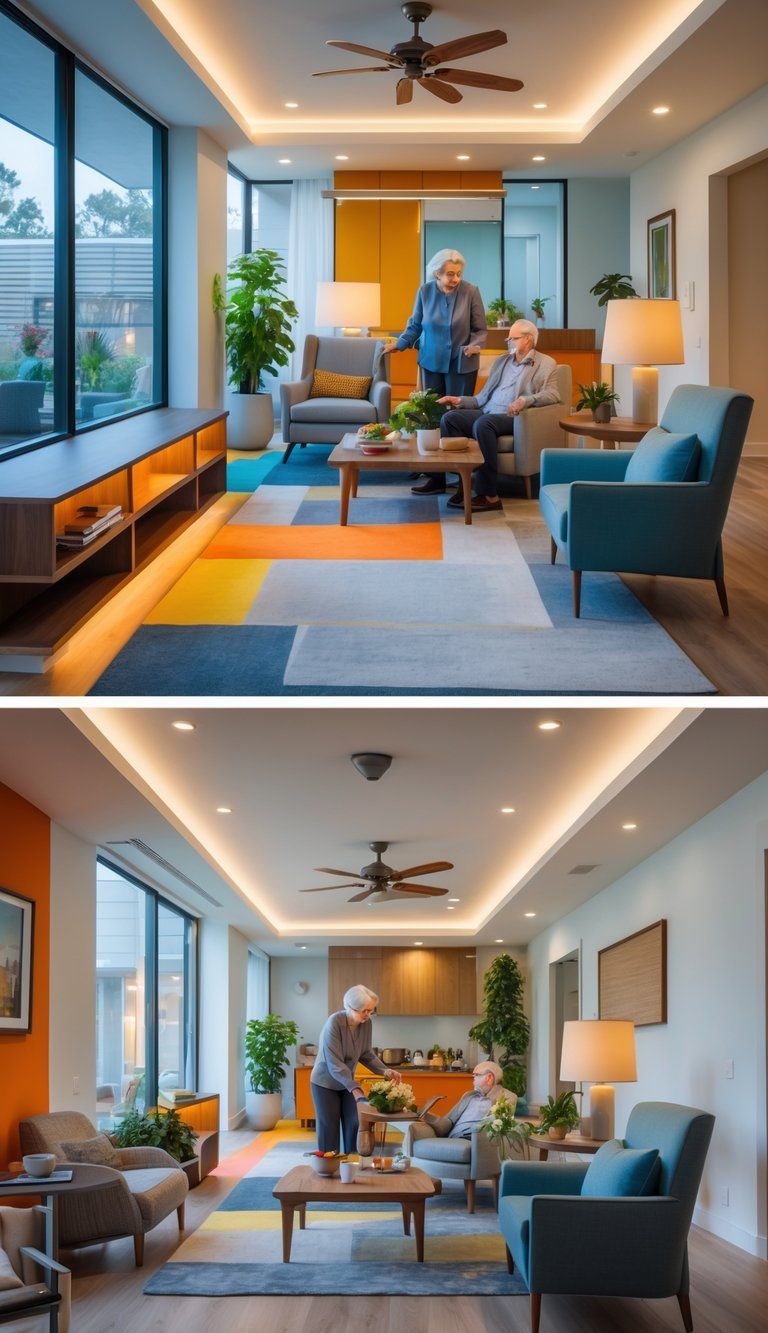
Good lighting and smart color choices matter more as you get older. These details don’t just make your home look good—they actually keep you safer and more independent.
Ensuring Good Lighting and Visibility
Your eyes need way more light as you age. Did you know a 60-year-old needs twice as much light as a 30-year-old just to see the same way?
Try these lighting upgrades:
- Add more light fixtures—especially in hallways and on stairs
- Use higher wattage bulbs (or bright LEDs)
- Install dimmer switches so you can adjust brightness
- Cut down on glare with frosted bulbs and smart placement
Natural light helps, too. Keep windows clean and use sheer curtains to let daylight in but cut the glare. Arrange furniture to make the most of that sunlight, especially for reading or hobbies.
Task Lighting for Safety and Comfort
Task lighting puts bright light right where you need it. It makes daily stuff easier and helps prevent accidents.
Kitchen Task Lighting:
- Under-cabinet lights for counters
- Pendant lights over islands or sinks
- Lights inside cabinets so you can actually see
Bathroom Safety Lighting:
- Vanity lights at face level (not overhead) to avoid shadows
- Motion-sensor night lights for late-night trips
- Bright lights in the shower and tub area
Reading and Hobby Areas:
- Adjustable desk lamps for focused light
- Floor lamps behind chairs for over-the-shoulder light
- Table lamps with 75-100 watt equivalent bulbs for reading
Contrasting Color Edges for Better Perception
Color contrast makes it easier to tell where one surface ends and another begins. As vision changes, this becomes more important than ever.
High-Contrast Areas for Safety:
- Use dark stair nosings on light stairs (or vice versa)
- Pick colored toilet seats that stand out from white fixtures
- Choose outlet covers and switch plates that pop against the wall
Paint door frames a different color than the walls so doorways are easier to spot. Make sure cabinets, counters, and floors don’t all blend together.
Pick furniture that stands out from the floor. A dark sofa on a light rug (or the other way around) helps prevent stubbed toes. Even a bit of colored tape on glass doors can stop accidents before they happen.
Enhancing Outdoor Areas for Accessibility
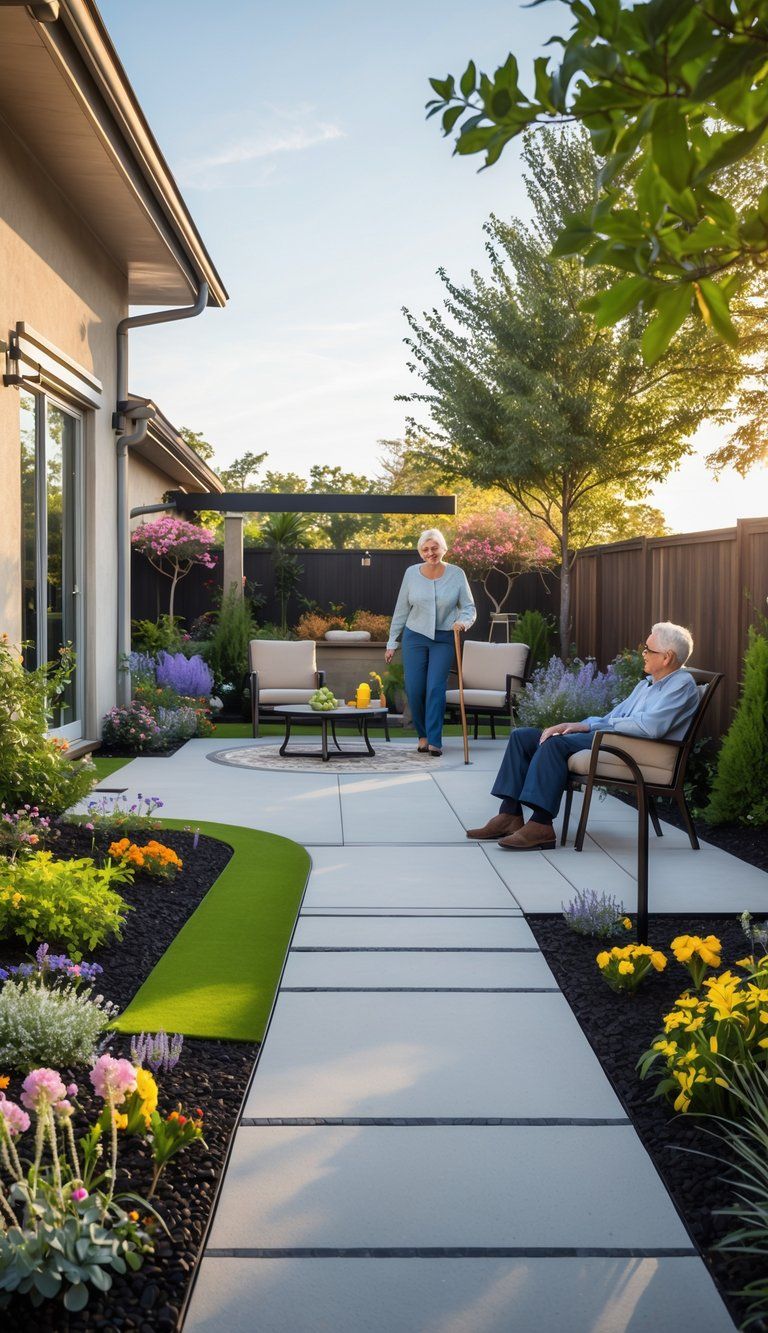
Outdoor spaces matter a lot for independence and enjoying life as you age. With the right design tweaks, your yard and entryways can be safer and more inviting for everyone.
Safe Pathways and Entryways
Start with the right materials for safe pathways. Textured concrete, certain pavers, or composite decking with grip are all good picks. Avoid polished stone or untreated wood—they get slick when wet.
Make sure your paths are at least 36 inches wide, so wheelchairs and walkers fit easily. For main walkways, 48 inches is even better—two people can walk side by side.
If you can, go for gentle slopes instead of steps. Where you need steps, add handrails on both sides and keep the height and depth of each step the same. Mark changes in elevation with contrasting colors at the edges.
Entryways should have zero-step entries or ramps with a gentle slope—no steeper than 1:12.
Tripping Hazard Reduction
Take a good look outside for tripping hazards. Common trouble spots:
- Uneven pavement or loose bricks
- Tree roots lifting up walkways
- Garden hoses across paths
- Abrupt changes in surface height
Fix cracks or bumps right away. Add edge restraints to garden beds to keep dirt and mulch off your paths.
Trim back plants and overhanging branches near walkways. Aim for at least 7 feet of headroom, and keep ground covers from spilling onto paths.
Store garden tools in accessible cabinets, and use hose reels to keep hoses tidy.
If you live somewhere with snow or ice, have a plan for clearing it and keep de-icer handy.
Lighting and Security Considerations
Outdoor lighting makes a huge difference at night. Place path lights at regular spots so you don’t get caught in the dark. Motion-activated lights near doors help with both safety and security.
Some good lighting ideas:
- Low-voltage LED path lights—they last and don’t use much energy
- Solar-powered lights—no wiring needed
- Bollard lights—add style and mark paths
- Under-rail lighting for steps and ramps
Put light switches where you can reach them (usually 36-44 inches from the ground). Motion sensors in key spots mean you don’t need your hands free.
Security upgrades can work with accessibility, too. Video doorbells let you see who’s there without rushing to answer. Smart locks mean no more fumbling for keys.
Add weather-resistant benches along longer paths for resting. It’s a small thing, but it makes getting outside easier for anyone who tires out or has mobility issues.
Energy Efficiency and Age-Friendly Solutions
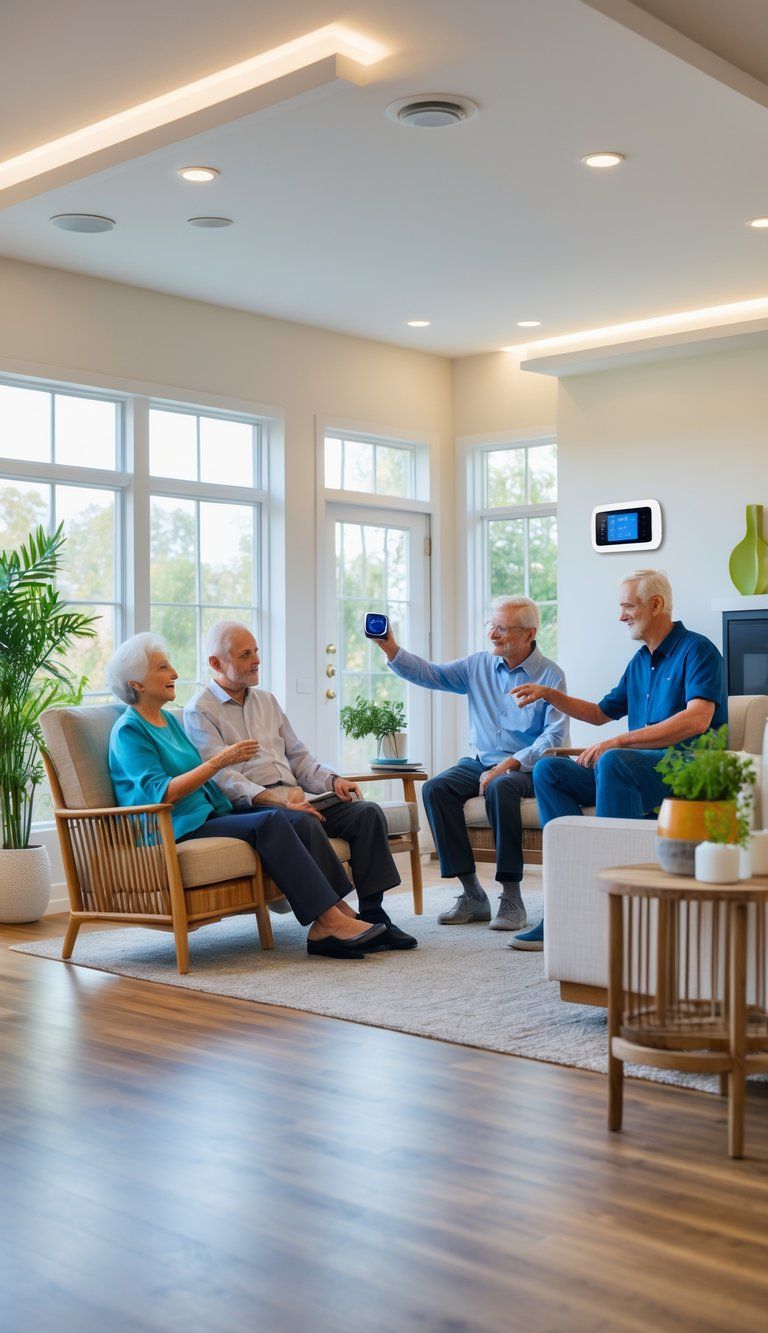
Making your home energy-efficient and age-friendly at the same time is a win-win. You’ll save money and make your space more comfortable and adaptable for whatever the future brings.
Energy-Efficient Home Modifications
Making energy-efficient tweaks at home can really cut down utility bills and make your space a lot more comfortable—no matter your age.
When you add proper insulation to the walls, attic, or basement, you help keep indoor temperatures steady. That way, your heating and cooling systems don’t have to work overtime.
Smart thermostats let you set temperatures ahead of time or adjust them from your phone. For older adults who notice temperature swings more, this can be a game-changer.
LED lighting uses up to 75% less energy than old-school bulbs and sticks around way longer. If changing bulbs is a hassle, this is honestly a huge relief.
If you put in double or triple-paned windows, you’ll notice fewer drafts and a cozier home. Plus, you’ll probably see your energy bills drop.
Popular Energy-Efficient Modifications:
- Programmable thermostats
- ENERGY STAR appliances
- Ceiling fans for better air movement
- Water-saving fixtures and faucets
- Solar panels for renewable energy
Sustainable Materials and Features
Choosing sustainable materials doesn’t just help the planet—it’s better for your health, too.
Low-VOC paints and finishes can make a big difference in indoor air quality, which matters a lot if you’ve got any respiratory issues.
Cork and bamboo flooring offer earth-friendly options that feel softer underfoot. Your joints might thank you, and there’s a chance you’ll lower your risk of injury from falls.
Recycled countertops and cabinets made from sustainable woods look great and don’t weigh so heavily on the environment.
Swapping in water-efficient fixtures like low-flow toilets and showerheads saves water and cuts down your bills. Many of these have simple controls, which is handy if you don’t have a lot of hand strength.
Solar panels can really shrink your electricity bills over time. These days, most systems come with easy-to-use apps, so even if you’re not tech-savvy, you can still keep an eye on your energy use.
Age-Friendly Design Strategies
Age-friendly design blends accessibility with energy efficiency. You can boost safety and cut down on wasted energy by adding motion-sensor lighting in hallways, bathrooms, and outside. These lights only turn on when someone’s nearby, so you’re not burning electricity for no reason.
Smart home systems let you control lighting, temperature, and security right from your phone or a simple wall panel. Managing your home gets a lot simpler, especially as mobility changes over time.
Key Age-Friendly Design Elements:
- Open floor plans help cut down on heating and cooling needs.
- South-facing windows bring in natural light and give you a bit of passive solar heating.
- Lever door handles are just easier to use than knobs, honestly.
- Kitchen workspaces at different heights make cooking and cleaning less of a stretch—literally.
- Easy-access storage keeps you from having to reach or bend too much.
If you place skylights and bigger windows in the right spots, you’ll get more natural lighting. That means less electricity use and, honestly, it might help with the seasonal blues that can hit as we get older.
Ceiling fans really pull their weight. They keep air moving in the summer, so you don’t need the AC as much, and in winter, they push warm air back down, making rooms more comfortable while saving on energy bills.

